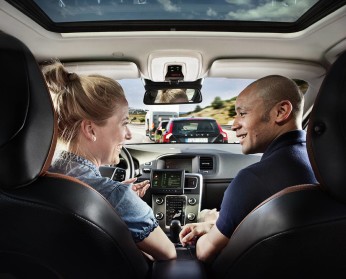
By: Manny Olojede,
Welcome to the future, Marty. Self-driving or autonomous cars will actually become a “thing” soon. But whose fault is it if the self-driving car runs a red light? The driver or the car? The manufacturer or some other third party? The chicken or the egg? Are robot cars even legal? With Tesla Motors’ recent announcement regarding its new “Auto-Pilot” software, there are numerous questions of legality and liability brought to the forefront of lawmakers’ agendas.
On October 14, 2015, Tesla Motors became the first automotive company to roll out advanced auto-pilot technology into its vehicles.[1] The Tesla Version 7.0auto-pilot software update will allow its Model S car to steer within lanes, change lanes, manage speed by using active, traffic-aware cruise control and scan for a parking space, alert [the driver] when one is available, and parallel park on command.[2] Though these features are an advancement in autonomous car technology, Tesla emphasizes that this update does not mean the car is fully autonomous and hands free.[3] In order for this software to function, your hands must be touching the wheel; otherwise the car will revert to manual mode after a few seconds.[4] Tesla is cautiously rolling out this technology, as it is aware of the few regulations surrounding autonomous vehicles.[5] However, Tesla does seek to allow its cars to be hands free in the future as new regulations are implemented and the technology improves.
Currently, the law surrounding self-driving cars in the United States has been ambiguous at best. In the majority of states, autonomous cars are not illegal, though New York is the only state that requires a “driver” to have his hands on the wheel at all times.[6] Only fourteen states have considered legislation regulating self-driving cars and nine of those have failed to pass bills specifically legalizing the cars, leaving the area of self-driving cars relatively grey.[7] Consequently, Tesla’s announcement has put on pressure on lawmakers to clarify these grey areas.
The National Highway Transportation Safety Administration has declined to comment on Tesla’s announcement but lauded the potential safety benefits of autonomous technology in statements made by Transportation Secretary Anthony Foxx earlier this year.[8] “The Department wants to speed the nation toward an era when vehicle safety isn’t just about surviving crashes; it’s about avoiding them,” Foxx said. “Connected, automated vehicles that can sense the environment around them and communicate with other vehicles and with infrastructure have the potential to revolutionize road safety and save thousands of lives.”[9] Based on these statements, autonomous technology seems to align with the future goals of the NHTSA and this may give a clue to as how regulations will be shaped surrounding them. However, it remains to be seen how the law will evolve.
Though the legal landscape surrounding self-driving cars in the United States has not been fully carved out, carmakers such as Volvo, Mercedes-Benz, and Google have indicated that they will likely accept the legal liabilities for their cars in the United States when they are put on sale to the general public. Volvo, in particular, has promised to accept full liability whenever one of its cars is in autonomous mode.[10] Though this promise may indicate car makers’ current confidence in the technology and hold carmakers strictly liable, Volvo, along with Mercedes and Google, have expressed that as the technology improves, they will expect fewer and fewer accidents.[11]
Ultimately, as the development of self-driving car technology quickly improves, it will be important for lawmakers to tackle these tough questions in a timely fashion. Carmakers have set the pace, and if the law does not catch up soon, there will be many more questions and problems for the government to answer about self-driving cars.
[1] Grayson Ullman, Tesla’s Self-driving Software: Is It Legal?, Fed scoop (October 16, 2015, 5:43 PM), http://fedscoop.com/teslas-self-driving-update-how-is-it-legal.
[2]Id. (citing Tesla Motors Team, Your Autopilot Has Arrived, Tesla Motors Blog (October 14, 2015), http://www.teslamotors.com/blog/your-autopilot-has-arrived)
[3] Molly McHugh, Tesla Cars Now Drive Themselves, Kinda, WIRED.com (October 14, 2015 6:19 PM), http://www.wired.com/2015/10/tesla-self-driving-over-air-update-live.
[4]Id.
[5]Id.
[6]Ullman, supra note 1.
[7]Id.
[8]Id. (citing Catherine Howden, Transportation Secretary Foxx Announces Plan to Add Two Automatic Emergency Braking Systems to Recommended Vehicle Advanced Technology Features, National Highway Transportation Safety Administration (January 22, 2015), http://www.nhtsa.gov/About+NHTSA/Press+Releases/NHTSA-sets-AEB-plans,-highlights-lives-saved-repoot)
[9]Id.
[10]Mark Harris, Why You Shouldn’t Worry About Liability for Self-Driving Car Accidents, IEEE Spectrum (October 12, 2015, 8:00PM), http://spectrum.ieee.org/cars-that-think/transportation/self-driving/why-you-shouldnt-worry-about-liability-for-selfdriving-car-accidents (citing Press Release, Volvo Car Group, US Urged to Establish Nationwide Federal Guidelines for Autonomous Driving (October 7, 2015), available athttps://www.media.volvocars.com/global/en-gb/media/pressreleases/167975/us-urged-to-establish-nationwide-federal-guidelines-for-autonomous-driving).
[11] Neil Briscoe, Car Makers to Accept Liability for Self-driving Cars, The Irish Times (October 12, 2015, 2:16 PM), http://www.irishtimes.com/life-and-style/motors/car-makers-to-accept-liability-for-self-driving-cars-1.2388608.
Photo Source: http://www.forcegt.com/wp-content/uploads/2012/09/volvo_road_train-10.jpg
